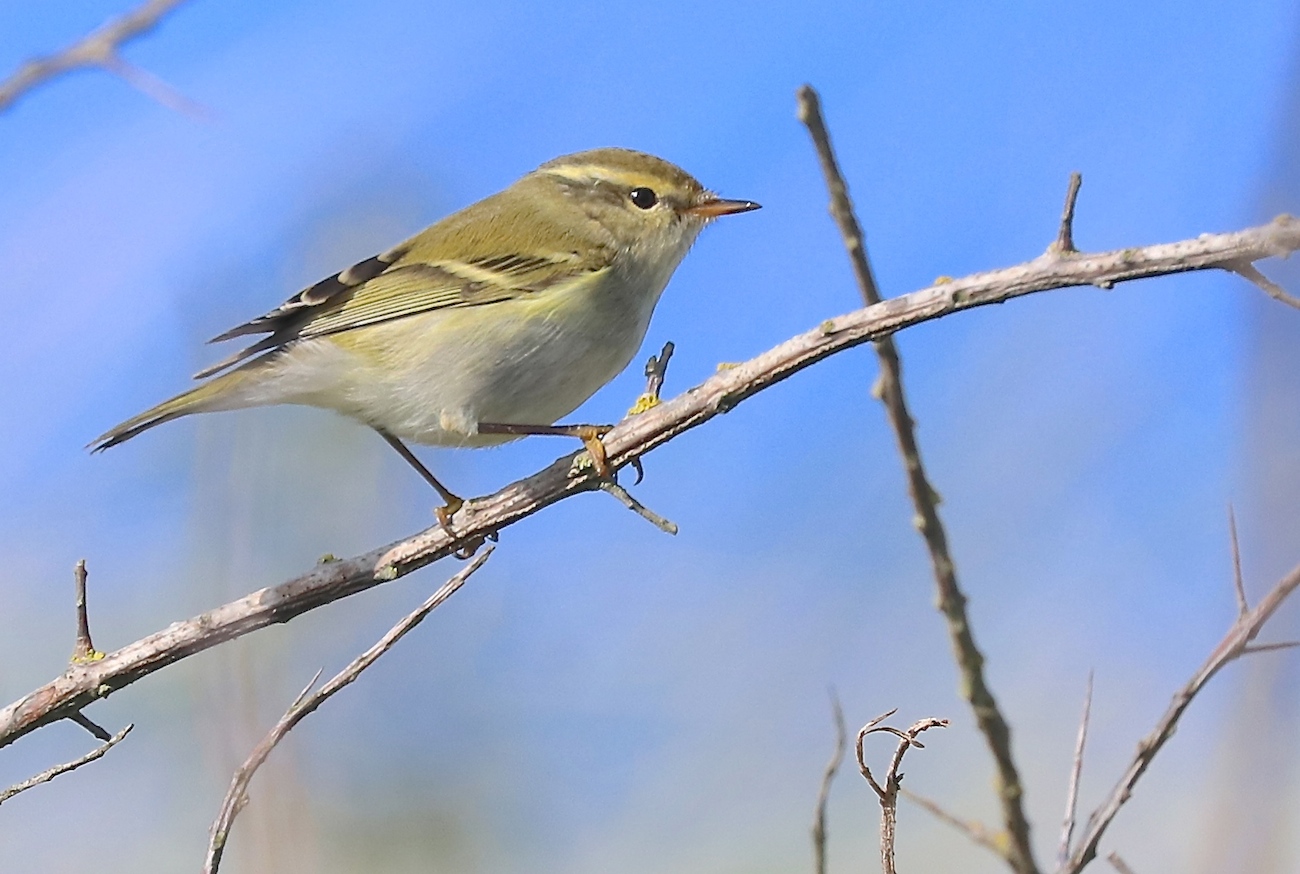Bladkoning
Phylloscopus inornatus · Yellow-browed Warbler
| Datum | 8 oktober 2021 |
|---|---|
| Locatie | Hondsbossche Zeewering |
| Fotograaf |
|
| Bekeken | 5229 × |
Vergeleken met voorgaande jaren dit jaar een stuk schaarser. |
Discussie
Max Berlijn
·
4 september 2022 23:06
Deze is er op tijd bij..
Peter de Knijff
·
5 september 2022 06:47
Wel opletten Max, eerder deze week al een vangst in Castricum (zie trektellen).
George Sangster
·
15 december 2022 14:37, gewijzigd 15 december 2022 14:49
Jong, AD, Torniainen, J, Bourski, OV, Heim, W & Edenius, L 2019. Tracing the origin of vagrant Siberian songbirds with stable isotopes : the case of Yellow-browed Warbler (Abrornis inornatus) in Fennoscandia. Ornis Fennica, 96(2), 90-99.
Vagrant birds are mesmerizing birdwatchers worldwide, but the nature of vagrancy andthe true origin of the vagrants are poorly known. To Western Europe, the massive Siberianland mass delivers most of the vagrant songbirds, e.g. Yellow-browed Warbler (YBW)(Abrornis inornatus, formerly Phylloscopus inornatus). In this study we used stable hydrogen isotope ratios in tail feathers ( 2Hf) from two ringing stations in northern Fennoscandia in an attempt to link vagrant YBW to potential regions of origin. We could do this thanks to a collection of samples from nestling and breeding adult YBW in Central Siberia. Compared with the nestling samples, the Fennoscandian 2Hf data indicated origins in the western and/or southern parts of the breeding range. The assignment map created in IsoMAP showed high probabilities of origins in the Komi Republic, N/NW of the UralMountains. Although our study rules out a large proportion of the YBW breeding range, our method could not pin-point a precise region of origin. The main reason for this is the similarity of environmental hydrogen isotope ratios across longitudes in Eurasia. For increased precision, we propose a multi-method approach (e.g. stable isotopes and genetics) based on significantly more data from across the vast and challenging Siberian territory. More international collaboration will be vital for this endeavour.
George Sangster
·
15 december 2022 14:43
Dufour, P, Åkesson, S, Hellström, M, Hewson, C, Lagerveld, S, Mitchell, L, Chernetsov, N, Schmaljohann, H & Crochet, P-A 2022. The Yellow-browed Warbler (Phylloscopus inornatus) as a model to understand vagrancy and its potential for the evolution of new migration routes. Movement Ecology 10: 59.
Why and how new migration routes emerge remain fundamental questions in ecology, particularly in the context of current global changes. In its early stages, when few individuals are involved, the evolution of new migration routes can be easily confused with vagrancy, i.e. the occurrence of individuals outside their regular breeding, non-breeding or migratory distribution ranges. Yet, vagrancy can in theory generate new migration routes if vagrants survive, return to their breeding grounds and transfer their new migration route to their offspring, thus increasing a new migratory phenotype in the population. Here, we review the conceptual framework and empirical challenges of distinguishing regular migration from vagrancy in small obligate migratory passerines and explain how this can inform our understanding of migration evolution. For this purpose, we use the Yellow-browed Warbler (Phylloscopus inornatus) as a case study. This Siberian species normally winters in southern Asia and its recent increase in occurrence in Western Europe has become a prominent evolutionary puzzle. We first review and discuss available evidence suggesting that the species is still mostly a vagrant in Western Europe but might be establishing a new migration route initiated by vagrants. We then list possible empirical approaches to check if some individuals really undertake regular migratory movements between Western Europe and Siberia, which would make this species an ideal model for studying the links between vagrancy and the emergence of new migratory routes.
Maarten Platteeuw
·
15 december 2022 15:28
Abrornis inornatus???
George Sangster
·
15 december 2022 21:44
Phylloscopus (sensu Voous 1977) is niet monofyletisch omdat Seicercus soorten 'ertussen' zitten. Dan kun je alles lumpen in een groot genus of de boel splitsen in meerdere kleinere (monofyletische) genera. Dickinson & Christidis (2014) deden dat laatste, en gebruikten Abrornis voor de bladkoningen en het Pallas Boszanger complex. Ze gebruikten ook Rhadina voor Fluiter en de twee bergfluiters. Dit is door sommigen overgenomen. De meeste taxonomen moeten hier echter niets van hebben en lumpen liever Seicercus in een groot genus Phylloscopus.
Dit is puur een kwestie van smaak (en wie je volgt).
Jan Hein van Steenis
·
17 december 2022 17:31
Als er een goede overeenkomst is tussen uiterlijk en DNA én je een groot genus daardoor overzichtelijker maakt, zoals hier, vind ik het splitten van genera goed te verdedigen.
Ik denk wel dat je een volledige dataset moet hebben voor je split.
Peter de Knijff
·
17 december 2022 18:10
Volgens HET Phylloscopen DNA verhaal (van Per A.), is het duidelijk 1 groep, dus dat is wel zo simpel. Waarom dan ingewikkeld maken?
Wim Wiegant
·
17 december 2022 22:11
Beste P,
Het P-verhaal van Per A...?
Is het tegenwoordig verboden om achternamen te gebruiken...?
Met de informatie. zonder verdere referenties, schiet de gemiddelde lezer van deze website niet veel op.
Ik als bovengemiddelde lezer ook niet.
George Sangster
·
17 december 2022 22:56
Alström, P, Rheindt, FE, Zhang, R, Zhao, M, Wang, J, Zhu, X, et al. 2018. Complete species-level phylogeny of the leaf warbler (Aves: Phylloscopidae) radiation. Molecular Phylogenetics and Evolution 126: 141-152.
Rob van Bemmelen
·
15 mei 2023 14:41
Ozsanlav-Harris et al (2023) Exploring the origins of vagrant Yellow-browed Warblers in WesternEurope. Preprint at Authorea
Bozó & Csörgő (2023) Causes of vagrancy of North Asian passerines in western Europe. Ibis https://doi.org/10.1111/ibi.13226
Gebruikers van het forum gaan akkoord met de forumregels.

